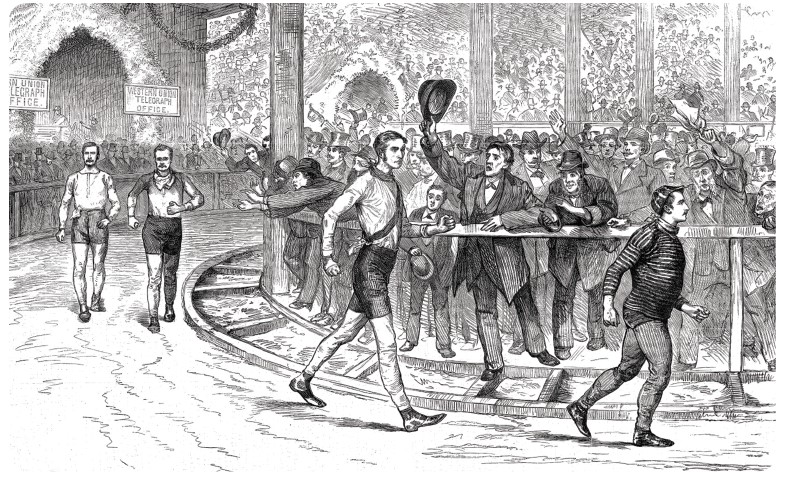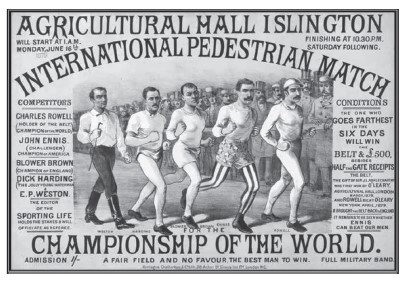Because of restrictions on activities in the past couple of months, many people have rediscovered the joy of taking walks. But did you know that watching people walk was once America’s favorite pastime?
In the 1870s and 80s, the sports craze of competitive walking became an obsession in the United States after first taking hold in England. Known as pedestrianism, these “walking matches” began in Europe with large competitions in major cities. Thousands of onlookers purchased tickets to watch pedestrians compete for prizes by walking a set number of miles in the shortest time or the longest distance in a predetermined amount of time.

American pedestrian matches increased in popularity in the years following the Civil War, partly due to increased numbers of people living in urban areas. The growth was also likely due in greater part, however, to increased endurance of many former soldiers who had taken long marches between 1861-1865 during their service in the war.
The average match required participants to walk 600 miles in six days on either an outdoor or indoor track. Races could only be held for a length of six days because public amusements were prohibited on Sundays. The event began at the stroke of midnight on Sunday evening, and the walkers would amble along the track until midnight the following Saturday.
Allowed to take a three-hour nap each day on a cot beside the track, participants spent the remaining 21 hours walking in front of spectators who would drop in to watch at any point during the event. The final hours of the matches were undeniably the most popular, as crowds enjoyed witnessing the effects of exhaustion and overexertion on the remaining men.
Many of the walking matches in Galveston were held in conjunction with other local celebrations, beginning in the business district and ending six days later in one of the public gardens near the beach.
One of the most famous 19th century American “peds” (as participants were called) was Edward Payson Weston, a door-to-door bookseller from Rhode Island. In 1860, he made a bet with a friend that Abraham Lincoln would lose the presidential election and of course lost the wager.
The terms of the bet were that the loser had to walk from Boston to Washington in ten days to witness the inauguration, which Weston did. The action generated a great deal of publicity, and his new vocation began.
Part of the attraction of the sport of walking races was the allure of gambling. Wagers could be placed on who would be the first pedestrian to drop out of a race, who would be the first to achieve the first 100 miles, and numerous other variables. Opportunities to fix races sometimes put the pedestrians themselves at risk.
Weston’s greatest accomplishment was walking 1,226 miles from Portland, Maine to Chicago in 26 days when he was 28 years old, for which he won a $20,000 prize. In Norwalk, Ohio, a man knocked him down, and two attempts were made to poison him along the way. Men who had bet against his success were suspected but never prosecuted.
As he quickly learned that showmanship was as important as endurance, Weston adjusted his attire to include ruffled shirts, sashes, and capes, and he always carried a cane. His biggest rival, Dan O’Leary, dressed simply and walked ramrod straight with his arms pumping like pistons. O’Leary was one of the first famous Irish-American athletes.
In 1867, Beadle and Adams published a dime book of “Pedestrianism” which provided practical instructions concerning walking methods, preparation of tracks, measurements, timing, scoring, and rules of conduct.
The booklet’s declaration of the importance of training and using professional trainers came as a surprise to many but was accepted by those who had the time and funds to incorporate them. Diet was also emphasized as crucial but not always in the same ways athletes would find familiar today.
Champagne was considered a stimulant, and many trainers instructed their walkers to consume large amounts of the bubbly beverage during a race. The method of consumption affected the success of this theory, and it should come as no surprise that those who experimented by drinking entire bottle at a time did not succeed in winning races.
In 1876, Weston was found to be chewing coca leaves during a race on the advice of his doctor. While the act was not officially against the rules, it was considered to be unsportsmanlike.
By current standards, suggestions of potions (now known to be poisonous) were recommended for those who drank too much and needed to scale back their consumption. One of these was the shocking substitution of ammonia for the accustomed alcohol.
Beadle and Adams also suggested that the mind of a walkist should be occupied or amused in some way. They claimed that a walk without a companion or taken for the purpose of making a call was referred to as a “constitutional” because it was not beneficial to ones health. Dependent on the “agreeability” of the companion, a walk executed with another person would provide encouragement and competition.
 As many contemporary experts agree, ingesting large amounts of water to replenish the body was recommended, but pedestrians took the attitudes toward water one step further. Though drinking it was encouraged, the pamphlet announced that it was not desirable to bathe during training “though a plunge into a river or the sea was serviceable.”
As many contemporary experts agree, ingesting large amounts of water to replenish the body was recommended, but pedestrians took the attitudes toward water one step further. Though drinking it was encouraged, the pamphlet announced that it was not desirable to bathe during training “though a plunge into a river or the sea was serviceable.”
Instead, the athlete was to sponge himself with 65 degree water each morning without soap, and rub his skin with a wet cloth until it glowed. In winter, a calico shirt was permissible for those who were “delicate,” but not a flannel. This prescription was said to be successful for those who exercised vigorously but also freely indulged in strong drink, tobacco, and the “usual excesses” of a fast city life.
Studious types who spent an average of 10 hours a day at work in offices were directed to give up smoking, green tea, and coffee. Though the standing desk seems like a new invention, the booklet suggested that two desks be employed, one at a sitting height and one adapted for standing.
This was supposed to provide enough stimulation to avoid the need for green tea when drowsy. Hour by hour schedules were also outlined which encouraged walking in the heat of the day.
By the late 1870s, more women than ever before took part in walking races. Activities of pedestriennes were front-page news across the nation.
While their most ardent fans looked upon the female athletes as heroines, many viewed the public exhibitions as shameful. Newspaper editors and preachers’ sermons objected to the immodesty they claimed was exhibited by both men and women in walking races.
Some promoters reduced the sport to a sideshow where ambitious girls and women were exploited for the sake of profit. Crowds were larger if the girls dressed in "cheap silk and cotton velvet and spangles" and covered themselves with a number of strategically placed "embarrassing bows." Jaunty walking dresses were often shortened to prevent tripping, which resulted in ankles being exposed with each stride.
In the middle of December 1879, producers of the Grand Ladies' International Tournament for the Championship Belt of the World attempted to repair the image of the women’s sport to athletic contests, requiring each contestant to pledge not to engage in quarreling, loud talking, profane or obscene language; to keep herself perfectly neat and clean; not to appear on the track in tights without a dress covering them; and to always have her hair neatly arranged.
Throughout the race, the performers were models of decorum, and their costumes were in good taste. Following this return of propriety, however, female pedestrianism ceased to exist in the United States as a profitable spectator sport. The last one in Galveston was held in 1881.
Later in the 1880s, young Galvestonian Frederick Feigle, a clerk at Flake & Company was successful in winning several local walking races and enjoyed a short burst of local celebrity. As late as 1890, walking matches were popular events at the Texas State Fair and drew large crowds.
One of the lasting legacies of pedestrianism is corporate sponsorship of athletes. O’Leary, for example, was the spokesman for a brand of salt. Other walkists were sponsored by newspapers and clothiers, and they sometimes raced in shirts with their sponsor’s logos.
The invention of the safety bicycle caused cycling to take the lead as the most popular international sport in 1885. The design, which was faster and more nimble than earlier models, provided quick-paced races that were more exciting for spectators to watch.
Galveston Island remains an ideal place for long walks, but now they are taken for views and company rather than competition.